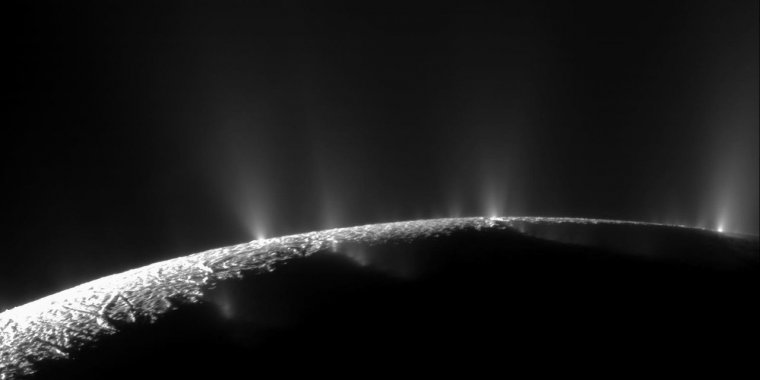| News / Space News |
NASA Cassini Data Reveals Building Block for Life in Enceladus’ Ocean
Using data collected by NASA’s Cassini mission, an international team of scientists has discovered phosphorus – an essential chemical element for life – locked inside salt-rich ice grains ejected into space from Enceladus.

Dramatic plumes, both large and small, spray water ice out from many locations along the famed "tiger stripes" near the south pole of Saturn's moon Enceladus. The tiger stripes are fissures that spray icy particles, water vapor and organic compounds. Photo: NASA/JPL-Caltech/Space Science Institute
The small moon is known to possess a subsurface ocean, and water from that ocean erupts through cracks in Enceladus’ icy crust as geysers at its south pole, creating a plume.
The plume then feeds Saturn’s E ring (a faint ring outside of the brighter main rings) with icy particles.
During its mission at the gas giant from 2004 to 2017, Cassini flew through the plume and E ring numerous times. Scientists found that Enceladus’ ice grains contain a rich array of minerals and organic compounds – including the ingredients for amino acids – associated with life as we know it.
Phosphorus, the least abundant of the essential elements necessary for biological processes, hadn’t been detected until now. The element is a building block for DNA, which forms chromosomes and carries genetic information, and is present in the bones of mammals, cell membranes, and ocean-dwelling plankton.
Phosphorus is also a fundamental part of energy-carrying molecules present in all life on Earth. Life wouldn’t be possible without it.
“We previously found that Enceladus’ ocean is rich in a variety of organic compounds,” said Frank Postberg, a planetary scientist at Freie Universität Berlin, Germany, who led the new study. “But now, this new result reveals the clear chemical signature of substantial amounts of phosphorus salts inside icy particles ejected into space by the small moon’s plume. It’s the first time this essential element has been discovered in an ocean beyond Earth.”
Previous analysis of Enceladus’ ice grains revealed concentrations of sodium, potassium, chlorine, and carbonate-containing compounds, and computer modeling suggested the subsurface ocean is of moderate alkalinity – all factors that favor habitable conditions.
The authors focused on data collected by Cassini’s Cosmic Dust Analyzer instrument when it sampled icy particles from Enceladus in Saturn’s E ring.
Many more ice particles were analyzed when Cassini flew through the E ring than when it went through just the plume, so the scientists were able to examine a much larger number of compositional signals there.
By doing this, they discovered high concentrations of sodium phosphates – molecules of chemically bound sodium, oxygen, hydrogen, and phosphorus – inside some of those grains.
Previous analysis of Enceladus’ ice grains revealed concentrations of sodium, potassium, chlorine, and carbonate-containing compounds, and computer modeling suggested the subsurface ocean is of moderate alkalinity – all factors that favor habitable conditions. (NASA)
YOU MAY ALSO LIKE





